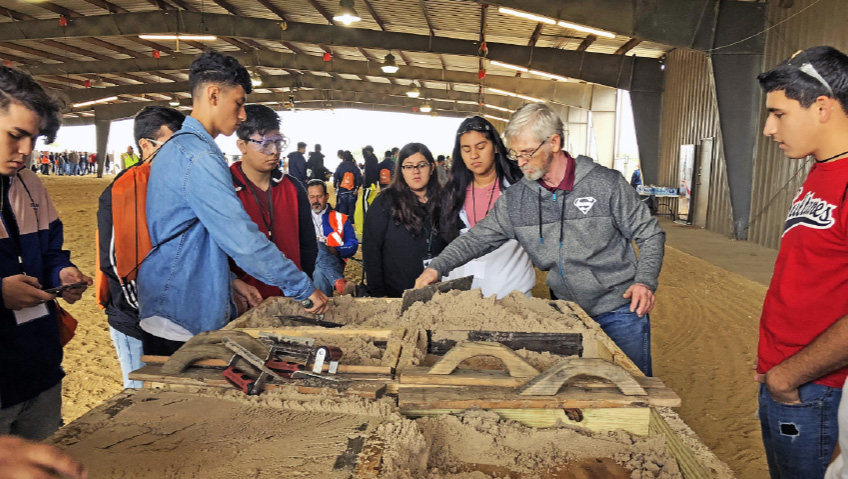Offering programs for career and technical education designed to bring together the range of construction industry needs and the life choices of new entrants, The National Center for Construction Education and Research (NCCER) trains and certifies students at every skill level, and bridges the gap between industry and school.
Consistency and quality together with highly adaptable workforce development and learning options guarantee that learners and would-be craft experts can now acquire industry-recognized certifications and credentials.
Better careers, better industry
NCCER’s thorough and relevant workforce development programs foster the career advancement of individuals and aid the expansion of the broader industry. The result is a more skilled and effective workforce and a more vibrant industrial sector made up of a variety of people whose lives have been enhanced by quality construction education.
Established in the mid-90s when 11 top contractors banded together to standardize training and offer certifications accepted by the industry, NCCER now has more than 1,000 national and international organizations authorized to offer credentials and certifications that have been used in all fifty U.S. states and twenty countries.
“When you think of construction, it’s an opportunity for entrepreneurship,” says Jennifer Wilkerson, NCCER’s Vice President of Innovation and Advancement. “What’s probably most interesting about construction to me is that someone can start on their tools and one day own their own business.”
Wilkerson’s husband did just that. After completing welding trade school and working for the Dade County school system, he ended up owning his own welding fabrication shop.
“There are a lot of great pathways,” Wilkinson says. “You can go into a craft, loving what you do and knowing this is what you want to do, or you can move up to crew leader, foreman, superintendent, project manager—whatever it might be that you want.”
She stresses that a lot of engineering programs and colleges—for example, mechanical engineering—want people who already have experience in welding, trades, or electrical engineering.
Wilkerson adds that the attitude surrounding construction is changing a bit, with a greater push toward specific career and technical education and not necessarily university. In this country, until very recently, she says, success was defined in one very specific way, which has led to a move through the years away from what was once called industrial arts. In the past few years, however, she’s seen more career and technical education programs start at schools, along with more enrollments.
This also makes good sense financially as many construction companies pay for employees to go through the apprenticeship program, whether in-house or through a college or training organization. “There are lots of opportunities but you’re also looking at the opportunity to work while you’re going to school,” she says.
Broadcasting the benefits
Getting the important message out to students about the many benefits of a construction career remains a bit of a challenge, however.
“We have to do better,” says Wilkerson. “If construction told the story of the hospitals and community centers we’re building, and what we do after natural catastrophes and how we’re the builders and helpers of those communities, many more young people would be interested.”
And make no mistake, younger people are desperately needed. For every four workers who leave the industry right now, only one comes in, and with one-in-four employees in the construction industry older than 55, workers will be (and already are!) in short supply.
“Construction tends to be a short game: I need people today, I need people tomorrow, I don’t have time to wait,” Wilkerson says. “Yes, you need a short game, but you’d better have a long game, too. And the long game is, ‘what are the closest high schools to your projects? Are you sending anyone out to talk to these kids?’ We’re so focused on the urgency of hiring today we’re not thinking about tomorrow, and we’re paying the price for that.”
Women are also being encouraged to enter an industry that has long been male-dominated. To connect with women and assess the issues anew, NCCER interviewed 176 tradeswomen in the field on project sites, in addition to 770 women who weren’t just in the field but also managers, talking to them about how to get more women into the industry.
“We found out, even from the managers, that what women bring to a site is a sense of teamwork,” says Wilkerson. “Women are very focused on everyone doing well; that’s just part of who they are. And while women don’t have the same physical strength or the experience of men, they tend to truly follow the design plans as they’re designed, which includes technology and safer and simpler ways to do things. They follow those plans better and this is noticed and talked about.”
As the lure of the construction industry includes the chance to learn skills and have opportunities to move up while earning solid money, there’s room for flexibility, too, which is especially appealing when it comes to parents and the need for work-life balance.
“Maybe the industry needs to think about shift work and people coming in earlier or staying later and working out schedules that allow for project sites to go longer as you’re dividing up the staff on who can work,” Wilkerson posits. “We’re hoping to help these contractors understand what we need to do and why they need to bring in women—and the benefits of it.”
Progress is underway, but Wilkerson believes more needs to be done, and with only 11 percent of the construction workforce being women, it’s difficult to see the growth.
“Women who’ve been working for years in the field have yet to see a female superintendent or a female project manager,” she adds. “We need to bring women in at that level because the only way you’re going to get women to see the opportunities and stay is if you have them in those positions.”
Launching careers
Another way NCCER promotes awareness is through its Build Your Future (BYF) initiative.
Build Your Future is a grassroots initiative that NCCER has had from the beginning to promote career awareness and how, over the years, you can become so much more. The program offers everything from career packs for career fairs to resources for teachers, parents, contractors, students, and veterans, along with relevant presentations and games for mentors to use in classrooms, all free of charge.
CareerStarter, a free career exploration tool available through the Build Your Future initiative, was released in August 2022 to inform candidates of where to go for various types of training or to get a certain type of job. This program is aimed not only at students but at anyone changing careers.
“If you look at it from a school perspective, students can build a profile and put in information about themselves while they’re still in high school,” Wilkerson explains. “They can look at contractors that have set up pages to advertise themselves. We then ask contractors to put in entry-level jobs, not jobs that need three or four years’ experience.”
Whether it’s summer internships or simply finding something to do after graduation, the CareerStarter allows colleges, community colleges, and training programs to build their own pages with information to help students discover if they want to go into a training program first or directly into a job. The ultimate goal is for them to actually make those connections after exploring the career-awareness aspect.
“The response has been really positive,” Wilkerson says. “About 22 percent of the students in construction CTE programs go into the industry. We’re asking ourselves, why are the other 78 percent that’s taking at least one construction program in school not going into our industry?”
Upon examination, NCCER found teachers simply don’t know the relevant information to pass to their students and had no connection with contracting firms that would offer entry-level jobs. CareerStarter aims to change that with its platform, offering information that assists students in searching for these jobs and a place to connect for both students and teachers.
“It’s been nice hearing back from the teachers, the contractors, and the students themselves who are super excited that they’re now able to make connections,” Wilkerson says.
Supporting small business
Training remains key, and while NCCER’s training has primarily been apprenticeship-based, the organization is focusing now on how to help those small to midsize companies that don’t have training programs and aren’t connected with a training organization. To that end, NCCER is looking at developing its training into bite-sized, just-in-time segments so that would-be students can enroll in self-paced online training that doesn’t have to be led by an instructor.
“We’re looking at how to encourage people to practice their skills more, and to be able to show how the quality of their performance improves as they go through these programs,” says Wilkerson. “I’m really excited about what we’re doing and how it will look when we release these programs.”
Coming together
To push the understanding that the construction industry can be a career for anyone, Wilkerson says the industry needs to come together.
“We haven’t done a good job talking about it. We haven’t found our voice yet, and I think we need to work on that. It means going to the schools—even the middle schools—and supporting programs.”
Changing misconceptions will help, too, she adds, particularly when people don’t see the stadiums, hospitals, schools, or community centers that are built. Construction is so much more, and all of it, of course, relies on proper training.
“Training leads to retaining—and that’s how you get retention,” Wilkerson says. “People want a clear career pathway. One of the things we have to improve is showing that career path. We have to provide the development for them to get there, so it’s really important that there are training programs,” she shares.
“We as an industry have to understand that people want to see their career trajectory, and they need to know they’re going somewhere.”













